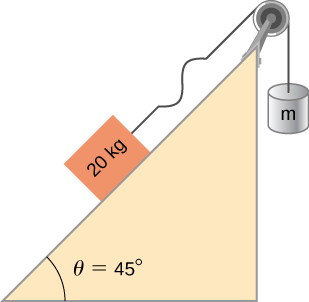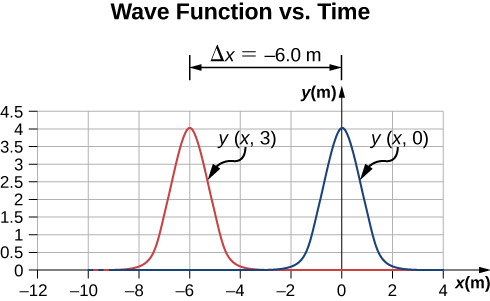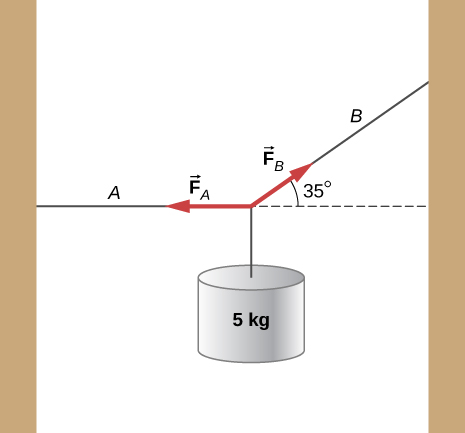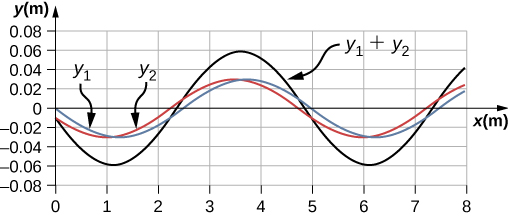-
Home
- University physics volume 1
- Unit 2. waves and acoustics
- Waves
- Standing waves and resonance
A seismograph records the S- and P-waves from an earthquake 20.00 s apart. If they traveled the same path at constant wave speeds of
and
how far away is the epicenter of the earthquake?
Got questions? Get instant answers now!
Consider what is shown below. A 20.00-kg mass rests on a frictionless ramp inclined at
. A string with a linear mass density of
is attached to the 20.00-kg mass. The string passes over a frictionless pulley of negligible mass and is attached to a hanging mass (
m ). The system is in static equilibrium. A wave is induced on the string and travels up the ramp. (a) What is the mass of the hanging mass (
m )? (b) At what wave speed does the wave travel up the string?

a.
; b.
Got questions? Get instant answers now!
Consider the superposition of three wave functions
and
What is the height of the resulting wave at position
at time
Got questions? Get instant answers now!
A string has a mass of 150 g and a length of 3.4 m. One end of the string is fixed to a lab stand and the other is attached to a spring with a spring constant of
The free end of the spring is attached to another lab pole. The tension in the string is maintained by the spring. The lab poles are separated by a distance that stretches the spring 2.00 cm. The string is plucked and a pulse travels along the string. What is the propagation speed of the pulse?
Got questions? Get instant answers now!
A standing wave is produced on a string under a tension of 70.0 N by two sinusoidal transverse waves that are identical, but moving in opposite directions. The string is fixed at
and
Nodes appear at
2.00 m, 4.00 m, 6.00 m, 8.00 m, and 10.00 m. The amplitude of the standing wave is 3.00 cm. It takes 0.10 s for the antinodes to make one complete oscillation. (a) What are the wave functions of the two sine waves that produce the standing wave? (b) What are the maximum velocity and acceleration of the string, perpendicular to the direction of motion of the transverse waves, at the antinodes?
Got questions? Get instant answers now!
A string with a length of 4 m is held under a constant tension. The string has a linear mass density of
Two resonant frequencies of the string are 400 Hz and 480 Hz. There are no resonant frequencies between the two frequencies. (a) What are the wavelengths of the two resonant modes? (b) What is the tension in the string?
a.
; b.
Got questions? Get instant answers now!
Challenge problems
A copper wire has a radius of
and a length of 5.0 m. The wire is placed under a tension of 3000 N and the wire stretches by a small amount. The wire is plucked and a pulse travels down the wire. What is the propagation speed of the pulse? (Assume the temperature does not change:
Got questions? Get instant answers now!
A pulse moving along the
x axis can be modeled as the wave function
(a)What are the direction and propagation speed of the pulse? (b) How far has the wave moved in 3.00 s? (c) Plot the pulse using a spreadsheet at time
and
to verify your answer in part (b).
a. Moves in the negative
x direction at a propagation speed of
. b.
c.

Got questions? Get instant answers now!
A string with a linear mass density of
is fixed at both ends. A 5.0-kg mass is hung from the string, as shown below. If a pulse is sent along section
A , what is the wave speed in section
A and the wave speed in section
B ?

Got questions? Get instant answers now!
Consider two wave functions
and
. What is the wave function resulting from the interference of the two wave? (
Hint:
and
.)
Got questions? Get instant answers now!
The wave function that models a standing wave is given as
. What are two wave functions that interfere to form this wave function? Plot the two wave functions and the sum of the sum of the two wave functions at
to verify your answer.
Got questions? Get instant answers now!
Consider two wave functions
and
. The resultant wave form when you add the two functions is
Consider the case where
, and
. (a) Where are the first three nodes of the standing wave function starting at zero and moving in the positive
x direction? (b) Using a spreadsheet, plot the two wave functions and the resulting function at time
to verify your answer.
;

Got questions? Get instant answers now!
Questions & Answers
evolutionary history and relationship of an organism or group of organisms
AI-Robot
the study of living organisms and their interactions with one another and their environments
AI-Robot
HOW CAN MAN ORGAN FUNCTION
the diagram of the digestive system
allimentary cannel
Ogenrwot
They formed in two ways first when one sperm and one egg are splited by mitosis or two sperm and two eggs join together
Oluwatobi
Genetics is the study of heredity
Misack
how does twins formed?
Misack
discuss biological phenomenon and provide pieces of evidence to show that it was responsible for the formation of eukaryotic organelles
the study of living organisms and their interactions with one another and their environment.
Wine
discuss the biological phenomenon and provide pieces of evidence to show that it was responsible for the formation of eukaryotic organelles in an essay form
list any five characteristics of the blood cells
Shaker
lack electricity and its more savely than electronic microscope because its naturally by using of light
advantage of electronic microscope is easily and clearly while disadvantage is dangerous because its electronic. advantage of light microscope is savely and naturally by sun while disadvantage is not easily,means its not sharp and not clear
Abdullahi
cell theory state that every organisms composed of one or more cell,cell is the basic unit of life
Abdullahi
is like gone fail us
DENG
cells is the basic structure and functions of all living things
Ramadan
is organisms that are similar into groups called tara
Yamosa
in what situation (s) would be the use of a scanning electron microscope be ideal and why?
A scanning electron microscope (SEM) is ideal for situations requiring high-resolution imaging of surfaces. It is commonly used in materials science, biology, and geology to examine the topography and composition of samples at a nanoscale level. SEM is particularly useful for studying fine details,
Hilary
Got questions? Join the online conversation and get instant answers!
Source:
OpenStax, University physics volume 1. OpenStax CNX. Sep 19, 2016 Download for free at http://cnx.org/content/col12031/1.5
Google Play and the Google Play logo are trademarks of Google Inc.




